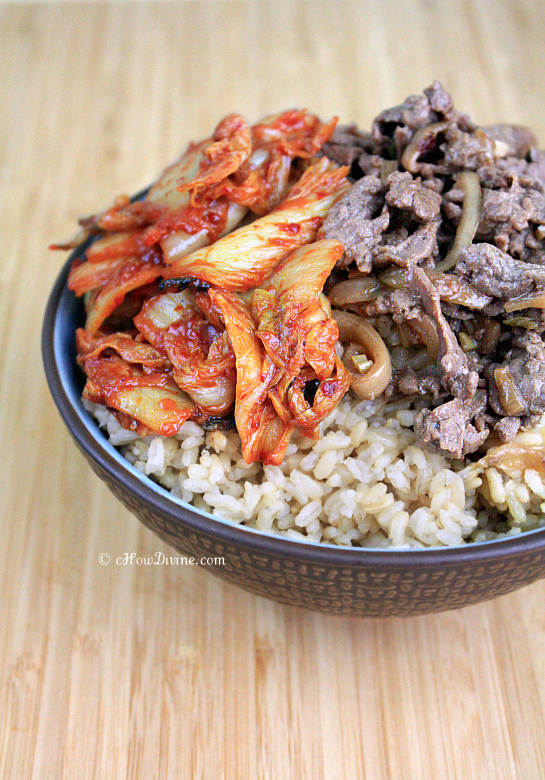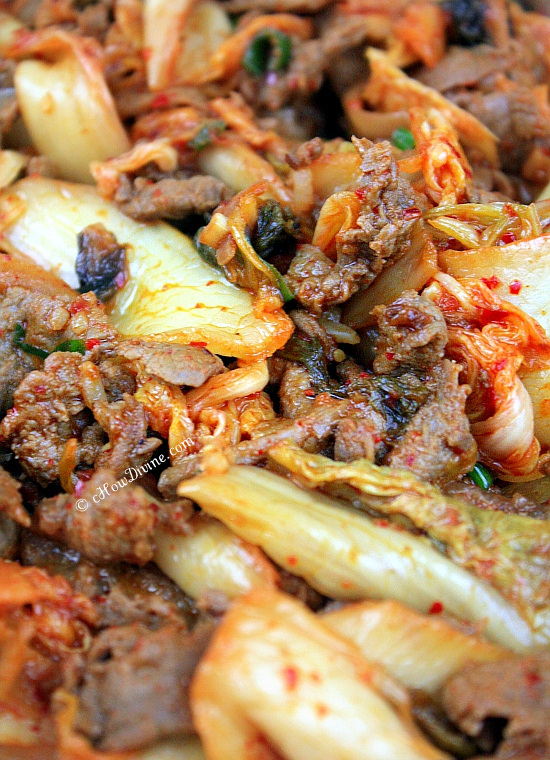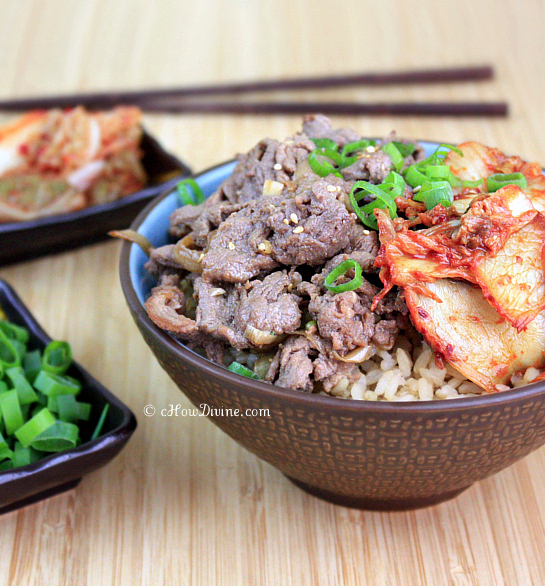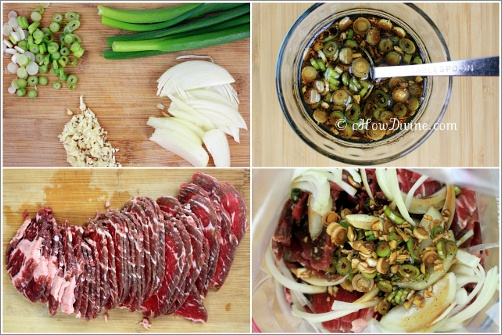Kimchi seems to be ubiquitous in the culinary world these days. Celebrity chefs are enamored with it. Small local markets and even the behemoth Whole Foods is carrying it. Suburbanites and hipsters alike are experimenting with it. And of course, food bloggers cook and write about it. It’s hard to believe that not too long ago, many people pinched their nose when in close proximity to kimchi. I think this is just a small part of a larger trend. I see more and more people embracing new experiences and accepting different types of cultures and lifestyles.
You won’t find anyone happier about this trend than me. For one, I don’t argue about politics and social issues as much, which makes for a quieter dinner party. But more importantly – because my stomach trumps all – this means I can find kimchi anywhere. Kimchi is a staple in my diet. I eat it all the time and would serve it for any occasion. Well, unless you are on a date with someone you want to get busy with. Then, I would say skip it. For all other occasions, it’s all good. 😉
I’m sure you’ve heard of the health benefits associated with kimchi by now. Kimchi, in most cases, is fermented. Through the process of fermentation, probiotics are formed. Probiotics are the beneficial bacteria that go to work in your gut to aid in digestion and nutrient absorption. They may also help lower cholesterol, improve your immune system, and treat eczema. These are just among other host of benefits. Eat kimchi raw, as is, if you want to keep the probiotics intact. But you can also sauté it, braise it, boil it, grill it, or roast it. Regardless of how you choose to prepare it, it will be delicious.
For this dish, I sautéed cabbage kimchi. Cooked kimchi tastes vastly different from its raw counterpart. If you haven’t tried cooking with it, try sautéing it. It is the easiest and quickest preparation, other than eating it raw. You can also mix the sautéed kimchi with the bulgogi (image below). It’s SO good.
BTW, sorry I haven’t been posting much lately. I just have a lot on my plate right now – residual effects from the stuff I alluded to in my last post. I will be back on schedule soon.
![]()
Kimchi Bulgoi Dubbap Recipe (Kimchi Bulgogi Rice Bowl)
Serves 3-4 people
Ingredients
For Bulgogi
1 lb tenderloin or rib eye
1/4 cup tamari (gluten-free soy sauce)
1 TB sesame oil
2 large cloves garlic, finely minced
1/4 large onion, sliced thinly
1/4 Asian pear, grated (totally optional)
2-3 TB agave nectar or honey
1 TB mirin
1/4 tsp black pepper
For Sautéd Kimchi
1 cup napa kimchi, sliced thinly
1 tsp gochujang (Korean red chili pepper paste)*
1-2 tsp brown sugar or agave nectar
canola oil for cooking
4 cups steamed (brown) rice
- Stir together tamari, sesame oil, minced garlic, agave nectar (or honey), mirin, and pepper.
- Place thinly-sliced beef, sliced onions, grated pear (if using) into a large mixing bowl or a large Ziploc bag for easy cleanup. Add prepared marinade from step 1 to the beef. Mix well. You can use your hands to massage the meat to ensure that the marinade is absorbed by the meat. Cover tightly. Marinate for at least 30 minutes. It can be marinated overnight.
- Heat a pan or a skillet on medium-high heat. Add canola oil to coat the pan/skillet. Remove the beef from the marinade and sauté until nicely browned. Don’t overcrowd the pan/skillet. Overcrowding will result in lowering of the temperature of the cooking surface; this will result in boiling or steaming of the meat. On moderately-high heat, the meat should cook very quickly – within minutes. Remove from pan. Tent with aluminum foil to keep warm.
- Add a drizzle of oil to the same pan with the bulgogi bits still stuck to the pan. Lower the heat to medium. Add the sliced kimchi. Sauté until the kimchi starts to look translucent. Add brown sugar or agave nectar and gochujang. Stir well until the gochujang is well mixed into the kimchi. Remove from heat. (If you’d like to mix the kimchi and bulgogi together, you can add the cooked beef back into the pan at this point. Stir until just heated.)
- Divide the steamed rice, bulgogi, and sautéed kimchi among four bowls. Garnish with chopped scallions and/or toasted sesame seeds if desired. Serve while still warm.
Cook’s Note*:
The beef should be sliced VERY thinly. It’s much easier to do so when the meat is partially frozen.
Bulgogi cooks very quickly due to the thinness of the meat. Don’t overcook it. You don’t want dried out meat, especially for this type of dish. You want it just cooked, super soft and moist, with some bulgogi broth left in the pan.
Skip the gochujang (Korean chili pepper paste) for a gluten-free option.





Oh that looks so good and filling. I have nonKorean people tell me about making their own Kimchi. My French chef told me he makes his own Kimchi with Piment d’Espelette lol..not sure if he is kidding or not. And Kimchi is one Korean dish I have never made yet. I think I’ve made almost every other widely consummed Korean dish there is..but can you believe I have never made Kimchi in my life?! I don’t buy banchan much (usually make at home), but it seems like Kimchi is the one (already made) item that I actually purchase at the market. Maybe I should try making it some day soon.
Thanks Miss Kim! It was very good & filling. As I always do when I have this, I overate and completely stuffed myself to the point I couldn’t move. You should make kimchi at home at least once, if only to say you’ve done it. I make it when I can, but when I’m busy, it really isn’t “worth it.” 😀 Store-bought stuff is pretty good these days (w/ the exception of TJ’s and others of same ilk). I do find it surprising, however, that so many non-Koreans make Kimchi on a regular basis. Your French chef might not be kidding. So, are French chefs as temperamental as we are led to believe???
Hope all is well with you and you will get back to your normalcy soon. 🙂 This is delicious! I always love rice bowl dishes on week nights. Beautiful shots!
Thanks Nami! I love rice bowl dishes too. There’s just something so “home” about them. I hope you and your family are well!
What a great dish! I love kimchi and I love any and all rice bowls. Hope things are looking up for you. Fun post – thank you.
Thank you John! I’m always so happy to hear people say they love kimchi. Not too long ago, many non-Koreans I knew had never tried kimchi! It’s so nice that I can now enjoy a good cold beer with some kimchi (and some Korean barbecue of course) with just about everyone I know! 😀 I hope you and your wife are well!
This looks delicious! Thanks to you and a couple other blogger friends, I’ve started buying kimchi from the local Asian market. Bob and I are now both addicted. I can’t wait to give dish a try. I love meals in a bowl like this! Thanks for sharing. Good luck to you and whatever is going on. Hope things work out int he best way!
Yay, another kimchi fan! It takes a couple of tries, but kimchi is definitely addicting. Try sautéing it, if you haven’t tried already. It has to be one of my favorites (not to mention easiest) ways to eat it. And they are wonderful in rice bowl dishes. Thanks MJ for your kind words. I hope you had a nice weekend! 😀
Yum! I just had kimchi pancakes in K-Town yesterday, so delicious!:-)
Love Love kimchi pancakes! We just went to this tofu place in K-town. They have veggie options. AND they make their own tofu. It may be perfect for you! 😀
You sure made my mouth water with your shots. Kimchi is always in my fridge and pot of pipping hot shin ramyeon with aged kimchi is my stress relief midnight snack haha
Anyhow, I love your dish…look at that beautiful beef-so gorgeous. I get excited about meat rather than some fancy dress-I accepted my weirdness LOL!
Great recipe and yummy pics–I hope you will get back to normal schedule soon! Rest before anything!
Haha, I was talking about that same thing the other day. I now enjoy food shopping more than I enjoy clothing or bag shopping. This is something I could not have predicted even five years ago. 😀 Thanks for your kind words as always Sandra. There is something to be said about the perfect combination that is shin ramyeon and perfectly soured kimchi!!!
Oh, how I miss this dish. I need to go and buy some kimchi! This is so mouthwatering! Pinned!
Thanks Julia! I’m so glad to hear from everyone how much they enjoy kimchi. It’s such music to my ears! Get yourself some kimchi soon! 😀
I know many people who will pinch their nose when in close proximity to kimchi. They are called my in-law parents. 😀 Anyway, I am glad to hear that you are well. Hopefully everything gets sorted soon.
They don’t know what they are missing! They just need to get over the initial smell factor. After that, they’ll be addicted like many people I know. One of my husband’s (non-Korean) colleagues makes her own kimchi and even gochujang. Now that’s impressive! I hope you and your family are well. 😀